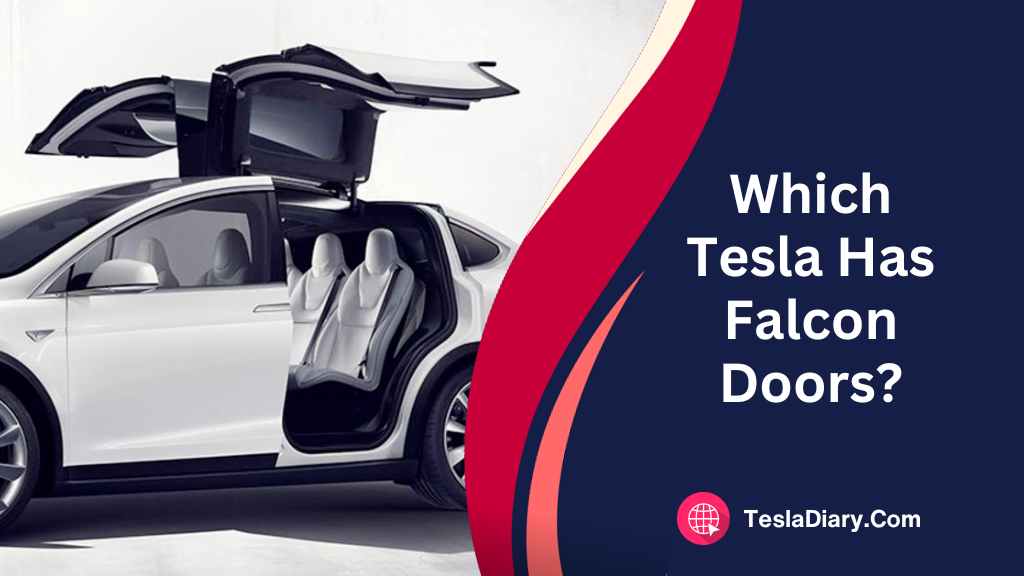Tesla, the trailblazing electric vehicle (EV) manufacturer led by Elon Musk, has always been at the forefront of innovation in the automotive industry.
Among its many groundbreaking features, the “Falcon Wing” doors stand out as a hallmark of Tesla’s commitment to pushing boundaries.
In this comprehensive guide, we will explore everything you need to know about Falcon Wing doors, including which Tesla models feature them, their advantages and disadvantages, and the technology behind these extraordinary doors.
What Are Falcon Wing Doors?
Falcon Wing doors are a revolutionary type of automotive door design that seamlessly blends elements of traditional hinged doors and gull-wing doors. Unlike conventional doors that swing outward or upward like gull-wing doors, Falcon Wing doors open upward, but with a unique twist.

These doors are hinged at the roof of the vehicle and feature a double-hinged system, allowing them to open in tight spaces while providing easier access to the interior.
Tesla Models with Falcon Wing Doors
Tesla has introduced Falcon Wing doors in one of its models:
Tesla Model X
The Tesla Model X, unveiled in 2015, is the pioneering vehicle that showcases the ingenuity of Falcon Wing doors. These doors are a defining feature of the Model X and have generated both excitement and debate within the automotive world.
Advantages of Falcon Wing Doors
Falcon Wing doors bring a range of advantages to the table:
1. Easier Entry and Exit
The upward-opening motion of Falcon Wing doors provides a broader and more convenient entry and exit point for passengers, especially in crowded parking spaces.
2. Unique Aesthetic
The Falcon Wing doors give the Model X a futuristic and captivating appearance, setting it apart from conventional SUVs and attracting attention wherever it goes.
3. Enhanced Weather Protection
When open, Falcon Wing doors act as a natural shield against rain, snow, and other weather conditions, making it effortless for passengers to load and unload without getting wet.
4. Improved Access to Rear Seats
These doors offer superior access to the second and third rows of seats compared to traditional SUVs, enhancing passenger comfort and convenience.
Disadvantages of Falcon Wing Doors
While they offer numerous benefits, Falcon Wing doors also come with some potential downsides:
1. Complex Mechanism
The mechanism behind Falcon Wing doors is intricate, relying on numerous sensors and motors. This complexity can lead to maintenance challenges and potential repair costs.
2. Limited Compatibility
Falcon Wing doors require ample vertical clearance to open fully. Low ceilings or narrow garages can limit their functionality, making them less practical in certain environments.
3. Slow Operation
Compared to traditional doors, Falcon Wing doors may open and close at a slower pace. This could be frustrating in situations where quick access is necessary.
4. Potential for Malfunctions
Like any mechanical component, Falcon Wing doors can experience malfunctions or sensor errors, resulting in operational issues that may require professional repair.
The Technology Behind Falcon Wing Doors
The unique and awe-inspiring nature of Falcon Wing doors is made possible by advanced technology and a sophisticated system of sensors and motors. Here are some key components and features of the technology that drives these remarkable doors:
1. Ultrasonic Sensors
Ultrasonic sensors play a pivotal role in detecting nearby objects and obstacles, ensuring that the doors can open without colliding with anything in their path.
2. Articulating Hinges
Falcon Wing doors employ an innovative double-hinged system with multiple pivot points, allowing them to open and close smoothly while adapting to various scenarios.
3. Smart Software
Tesla’s proprietary software oversees the operation of Falcon Wing doors, ensuring they open and close safely and efficiently, taking into account various factors such as vehicle speed and obstacle detection.
4. Auto-Adjustment
Falcon Wing doors have the ability to adjust their opening angle based on the available space, further ensuring they clear nearby obstacles without any issues.
1. Do all Tesla’s have Falcon doors?
No, not all Tesla vehicles have Falcon Wing doors. The only Tesla model equipped with Falcon Wing doors is the Tesla Model X. Other Tesla models, such as the Model S, Model 3, and Model Y, feature conventional door designs.
2. Which Tesla has spider doors?
Tesla does not offer a model with spider doors. Spider doors are a specific type of automotive door design characterized by an upward-opening single hinge and a low profile. Tesla’s door designs include Falcon Wing doors on the Model X and conventional doors on other models, but none of them feature spider doors.
3. Do any Teslas have butterfly doors?
No, Tesla does not currently offer any models with butterfly doors. Butterfly doors, also known as “dihedral doors,” are a unique door design that combines elements of both gull-wing and conventional doors. Tesla’s vehicles do not feature butterfly doors. However, some people call the Falcon Wing Doors Butterfly doors but they are not the same.
4. Which Tesla does Elon Musk use?
Elon Musk, the CEO of Tesla, has been known to drive various Tesla models over the years. However, one of his notable choices has been the Tesla Model S. He has been seen driving different versions of the Model S, showcasing his confidence in the product and its capabilities.
5. What is the most expensive Tesla?
The most expensive Tesla available for purchase is the Tesla Model S Plaid. The Model S Plaid is a high-performance variant of the Model S and comes with a hefty price tag due to its exceptional acceleration and range.
Conclusion
Falcon Wing doors are a testament to Tesla’s commitment to pushing the boundaries of automotive design and technology. The Model X remains the only Tesla model to feature these remarkable doors.
However, Tesla’s relentless pursuit of innovation suggests that future models may introduce new and exciting features.

